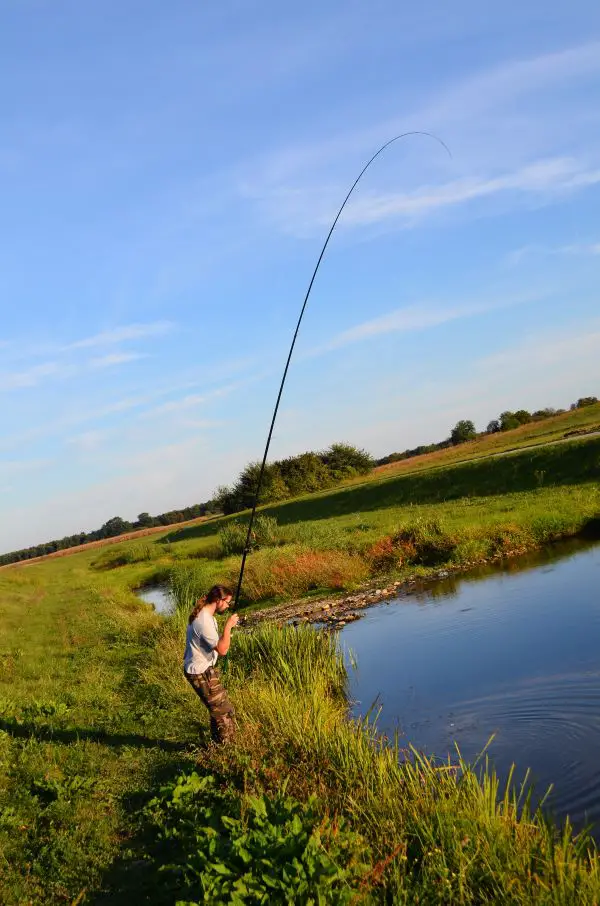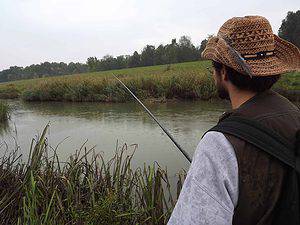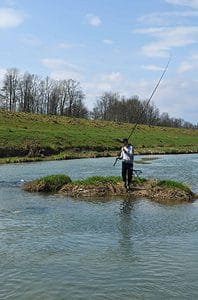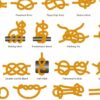Disclosure: Some posts contain affiliate links, which earn us a commission if you make a purchase through them. Positive Fishing © participates in various affiliate networks including the Amazon Services LLC Associates Program.
Bolognese fishing, or the Bolo system, is a fishing technique that combines using a specialised long rod and a float that looks like a large pole float.
In simple terms, it’s a controlled way of float fishing at long distances in very deep and flowing waters. Primarily used for river fishing, it can also be used for sea fishing – either from the shore or by boat.
The main purpose of bolognese fishing is to provide an efficient solution for fishing downstream. Bolognese rods are, therefore, long, as they need to enable holding the line above water, even when fishing far away from the bank and 50+ metres downstream!
But to understand bolognese fishing better, I will go through the following:
- Learn the differences between bolognese and match fishing
- Learn what are Bolognese fishing rods and reels
- What type of fishing line and floats are used for bolognese fishing?
- What are the fishing techniques used in bolognese fishing?
Bolognese Fishing Vs. Match Fishing

When talking about float fishing, we can say there are two main types: fishing with a rod without a reel (pole or whip fishing) and fishing with a rod and reel.
Float fishing with a rod and reel is represented by two very distinctive techniques: bolognese fishing, which originates from Italy, and match (or waggler) fishing which originates from the UK. These two float fishing techniques are very different, as they were designed for two specific fishing conditions.
In England, the wind is one of the main factors affecting float fishing. To tackle it, anglers have designed specific floats called wagglers (or sliders) that sink the mainline underwater, preventing the float’s movement due to wind. Also, they have designed special rods for waggler fishing. They are called match rods – typically between 12 to 14ft long.
Match rods are slim, sensitive, and have a parabolic action. Guides on match rods are set very close to each other to prevent the mainline from sticking to the rod blank if the day is rainy.
Waggler fishing is easier on slower waters at close distances. But It isn’t easy to control the float using shorter match rods when fishing fast waters, far downstream!
Bolognese fishing, designed for river fishing, has a completely different story. Bolognese rods have an important role – they must prevent the fishing line from touching the river surface and provide perfect control of the float you are drifting downstream!
Therefore, the rods must be long and reasonably strong, with a fast, responsive tip. However, their features have a logical downside – if match rods are cumbersome for river fishing, bolognese rods are a nightmare to use on windy days!
What Are Bolo Fishing Rods?

We have already covered the basic purpose of bolognese rods, but let us go into the details.
First, all bolognese rods are made as telescopic rods. They range in size from 4 metres to 10 or even more.
But from my experience, 5-7 meters is the sweet spot. A 4-metre bolognese rod is too short for any reasonable-sized river, and anything over 7 m is incredibly heavy, bulky, and hard to use with even a slight wind breeze. Not to mention the possibility of breaking a very expensive rod just because you used too much energy when trying to cast it.
Every section of a bolognese rod is armed with one guide, but the top sections often have additional sliding guides. Big space between guides allows for greater casts but brings a problem – if there is rain, your line will often stick to the blank. If this is annoying you, join the club – you are not the only one!
Tip: Rod guides are fixed rings for the line to pass through a rod. The line can then be cast out into the water without tangling.
Bolognese rods have a very important function: they need to cast your float a great distance; they also need to keep your line from touching the water, as if the line falls in the water, river current will pull it downstream, and you will both lose the quality of presentation and contact with your float.
They also need to be strong and fast, as a bolognese rod needs to be stiff while fishing, but at the same time, they need to have a very responsive tip that will allow perfect transmission through to the fish. In addition, it must prevent breaking the hook length line of smaller breaking strain.
To do all this, the rod can be rather expensive.
What Are The Best Bolognese Fishing Rods?
If you are after a rod that is top of the range, look at the Trabucco Energhia. This is one of the best bolognese rods on the market, and I have three of them (5, 6, and 7 m in length).
But if you want to enjoy quality time fishing the bolo-style, you do not need to break the bank: there are other good bolognese rods for a reasonable price! Check out the Mitchell Tanager T Bolo Fishing Rod for a more affordable option. This entry-level rod is available at 4m, 5m, and 6m lengths.
When choosing your rod, always try it in the store first. Once you decide on the right rod to buy, check the online stores for pricing comparisons. UK Bolo rods are available in many tackle shops, and many can be found on Amazon UK.
Never buy heavy bolo rods, as they will turn fishing into a nightmare, and never buy rods without additional sliding guides at the top!
Tip: It is really easy to break your bolognese rod. You should always be extra careful when assembling the sections! If they are not put into place correctly, and there is wobble between them, you have a perfect situation for breaking the rod. Keep that in mind!
What Is The Best Type Of Reel For Bolognese Fishing?
There is a limited choice of dedicated bolognese fishing reels on the market. Unlike match fishing (which utilises very light reels with shallow spools), you can use almost every reel designed for lure fishing if the gear ratio is high enough!
In bolognese fishing, everything is about speed. When you consistently drift your float 50 or more metres downstream, you will be eager to reel in as fast as possible to make another cast.
So you will need a ratio of at least a 6.0:1 reel. In my opinion, nothing stands even close to the legendary Shimano Stradic FL! It is both fast and strong.
Like in all their fishing gear, Shimano fishing reels will endure years and years of fishing and has one of the best drags on the market – which is a priority when using thin hook lengths and catching big fish!
What Fishing Line Is Best For Bolognese Fishing?
There is an infinite choice of monofilament fishing lines on the market, and you can use any of them to fish for bolognese fishing.
But – if you want to do this correctly, you should purchase a line that floats!
Why? If you use a sinking monofilament (which you should buy for match fishing), it will sink under the river’s surface and therefore be in the fast-moving current, which totally changes your bait presentation. Floating lines will drift downstream, but with a properly chosen rod length, you can tackle this without problems!
Trabucco makes some of the best bolognese fishing monofilaments, so be sure to check them out. The Trabucco – Fishing line t-force tournament class is an excellent choice for bolo angling.
Considering diameters, I am not a fan of using thin monofilaments. Why? Because they can make a tangling nightmare very quickly, especially if there is wind or rain (or both!).
I will use 0.20mm as the thinnest mainline, but if fishing in big rivers with a strong current and a strong rod, I will go up to 0.28mm.
With a thin mainline, you will not have any serious advantage, but the fishing will be much more fun. It can be quite frustrating if you get line tangles with every single cast (and trust me, it is near impossible not to get tangles when swinging a 6-7 m bolognese rod).
What Floats To Use When Bolognese Fishing?
Using two simple silicone sleeves, you need ‘’fixed’’ type floats with an antenna and a stabiliser fixed to the line on two points. You can then adjust to the desired depth by moving the float up and down on your line (this is one of the reasons why bolognese rods have to be very long, apart from controlling the float – you cannot fish at 5 metres depth with a fixed float if your rod is not at least 6 metres long!)
There is a simple rule: if the water is slow, you need stick floats, and if the water is faster, you need chunkier barrel-type floats!
Bolo Floats can weigh from 2 grams all the way to 20 grams, depending on the speed of the current that you are fishing!
TIP: For brighter days, always choose dark antennas – for cloudy days, choose a yellow or orange antenna!
Bolognese Fishing Techniques

Now that you have everything sorted let’s go bolognese fishing!
A couple of important steps are needed before we start fishing:
Plumbing The Depth
You can check your fishing spot depth with a simple and cheap lead sinker (a plummet) designed just for the purpose. Attach the plummet to the hook, cast it out, and keep adding depth by moving the float up along the line until the sinker is on the bottom and you can see your float (if your float is too low on the line, the float will sink).
Now you have found the depth, you can fine-tune your float according to the conditions and desired fish species.
Feed The Specific Fishing Area
Now, you can either start feeding/chumming the spot or start fishing. Bolognese is an active fishing technique that you use to cover as much water as possible. So, when you cast (and always cast a bit upstream), you should predict the trajectory path of your float and use your rod and reel to slowly drift your float down the exact position with full control.
When you loose feed, always calculate the depth and speed of the current to ensure the loose feed pre-bait is arriving at the bottom of the spot you are fishing.
Never let your float drift down freely – you must control it every moment!
Firstly, you need to react if there is a bite, and secondly, you want your bait to be presented as naturally as possible – and you will achieve this by controlling the float drift with your rod!
Always Fish Bolo Style Standing Up
One very important part of the bolo fishing technique is that you should always stand up to fish. This gives better control of your rod and float as it travels downstream, keeping the line behind the float.
When you get the hang of drifting downstream, you can start thinking about variations: changing the rig, changing the bait, depth, trajectory, etc.
Whilst it can be tiring, bolognese fishing can bring the angler tremendous results. But most importantly, enjoy your time on the river!
Final Thoughts
Bolognese fishing or bolo fishing is not just limited to the anglers in mainland countries of Europe; it has a viable use on many of our waters in the UK. Unfortunately, despite its tremendous benefits, it is extremely rare to see it used.
I hope this article has inspired you to go out and try this fishing method. In the right circumstances, catching all fish species, including carp, on deep commercials can be extremely fun and rewarding.
Please check out more of my fishing tips and guides to learn more about different fishing methods and styles.
- Winter Lure Fishing For Catching Zander In Rivers & Lakes - January 22, 2022
- What Is Bolognese Fishing? The Ultimate Guide To Bolo Fishing - December 29, 2021
- How To Catch Carp: The Best Carp Hookbaits Revealed - November 17, 2021

